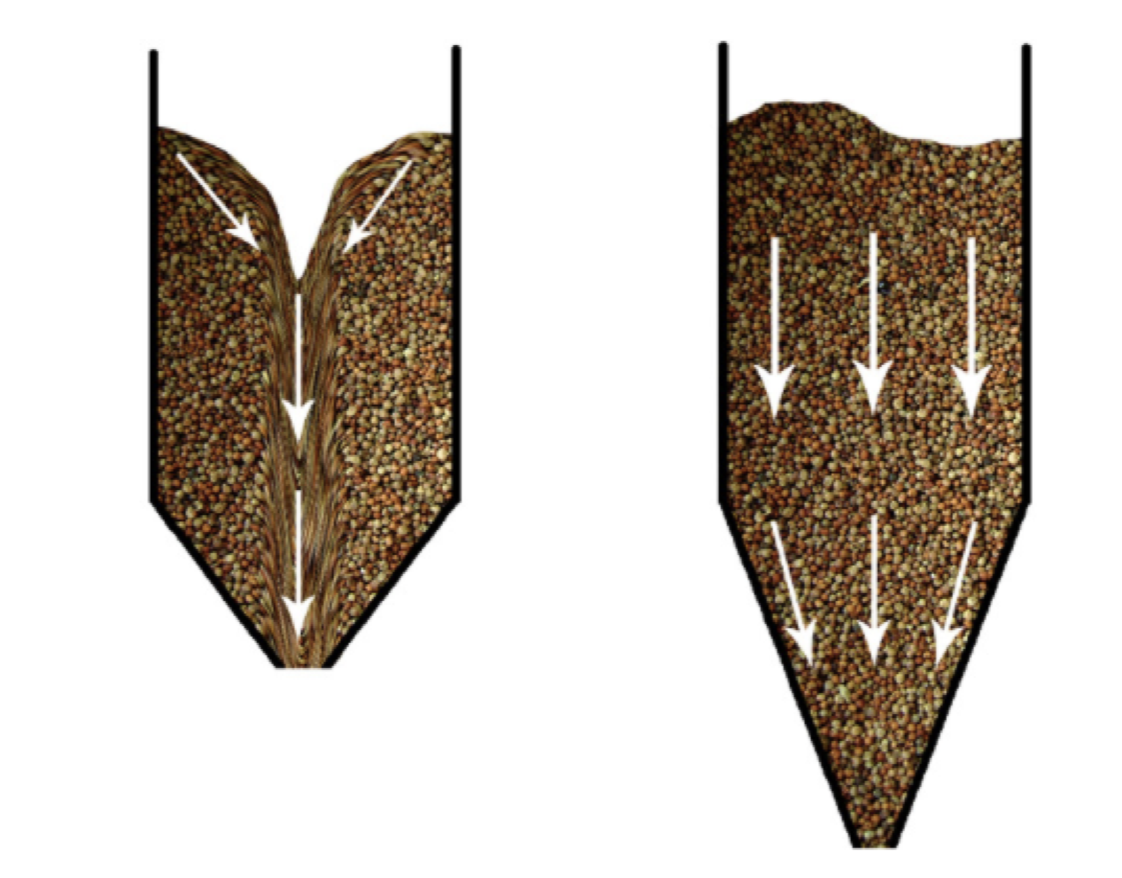Hopper Design & Powder Flow – Hopper Design Cliff Notes

There are two general flow patterns that can occur when a bulk solid is discharged from a hopper: funnel flow and mass flow. In funnel flow, an active flow channel forms above the outlet, with stagnant material remaining at the periphery. In mass flow, the entire solids bed is in motion when the material is discharged from the outlet. Funnel flow occurs when the walls of the hopper are not steep enough or have low enough friction to allow flow along them. Mass flow hoppers typically have steep and/or low-friction walls. Flow patterns are illustrated in Figure 1.

The choice between a funnel flow hopper and mass flow hopper depends on a number of factors. If a material has segregation tendencies, mass flow should be selected. Materials that are likely to cake or readily form stable ratholes should be handled in mass flow hoppers. Mass flow is also recommended when fine powders are handled, as they are more likely to flood feeders, and when applications require a steady solids discharge rate.
Funnel flow is fine as long as segregation is not a concern, the powder does not aerate, and the hopper outlet is large enough to prevent a stable rathole from forming. In many cases, the size of a hopper outlet required to prevent a stable rathole from developing is considerably larger than that required to avoid a cohesive arch from forming. In general, mass flow hoppers are preferred over funnel flow hoppers.
Flow properties
To design a hopper for reliable flow, the following bulk solids flow properties must be known: (1) cohesive strength, (2) internal friction, (3) compressibility, (4) wall friction, and (5) permeability. These properties are measured using shear cell, wall friction, and permeability testers. The relationship between a bulk material’s unconfined yield strength and major consolidation stress is called the flow function. The effective yield locus provides the relationship between the major consolidation stress and the effective angle of friction. Compressibility is the relationship between a material’s bulk density and major consolidation stress. Permeability relates the pressure drop through a bed of material and the superficial gas velocity. Details of the test equipment and testing procedures can be found in the 9th edition of Perry’s Chemical Engineers’ Handbook.
Mass flow hoppers
Two critical design parameters are specified for mass flow hoppers: the hopper angle and the size of the outlet. The hopper angle required to allow mass flow depends on the effective angle of friction δ, the wall friction angle, and the geometry of the hopper. Figures 2 and 3 provide recommended mass flow hopper angles for conical hoppers and hoppers with flat walls and slotted outlets based on analyses developed by Jenike [1,2]. Values of the allowable hopper angle θ’ are on the horizontal axis, and values of the angle of wall friction φ’ are on the vertical axis. The boundaries between mass flow and funnel flow depend on the effective angle of friction δ. Any combination of θ’ and φ’ that falls within the limiting mass flow region of the chart will provide mass flow.
Continue reading the full publication by Greg Mehos here: Hopper Design Cliff Notes

